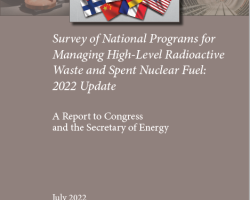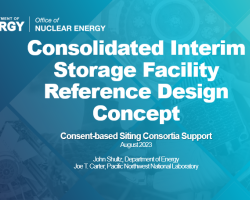Category of Content
Siting Experience Documents Only
Publication Date
Subject Matter
Keywords
Uncertainty quantification methodologies development for storage and trans- portation of used nuclear fuel: Pilot study on stress corrosion cracking of canister welds
Uncertainty quantification methodologies development for storage and trans- portation of used nuclear fuel: Pilot study on stress corrosion cracking of canister welds
Used Fuel Disposition Storage, Transportation and Disposal Interface Study
Used Fuel Disposition Storage, Transportation and Disposal Interface Study
Preliminary Report: Effects of Irradiation and Thermal Exposure on Elastomeric Seals for Cask Transportation and Storage
Preliminary Report: Effects of Irradiation and Thermal Exposure on Elastomeric Seals for Cask Transportation and Storage
Uncertainty quantification methodologies development for stress corrosion cracking of canister welds
Uncertainty quantification methodologies development for stress corrosion cracking of canister welds
Used Fuel Disposition Storage, Transportation and Disposal Interface Study
Used Fuel Disposition Storage, Transportation and Disposal Interface Study
SNF Interim Storage Canister Corrosion and Surface Environment Investigations
SNF Interim Storage Canister Corrosion and Surface Environment Investigations
Cost Implications of an Interim Storage Facility in the Waste Management System
Cost Implications of an Interim Storage Facility in the Waste Management System
Generic Design Alternatives for Dry Storage of Spent Nuclear Fuel
Generic Design Alternatives for Dry Storage of Spent Nuclear Fuel
Generic Design Alternatives for Dry Storage of Spent Nuclear Fuel
Generic Design Alternatives for Dry Storage of Spent Nuclear Fuel
Generic Design Alternatives for Dry Storage of Spent Nuclear Fuel
Generic Design Alternatives for Dry Storage of Spent Nuclear Fuel
Multi-Year Plan to Prepare DOE-Managed Spent fuel for Transportation
Multi-Year Plan to Prepare DOE-Managed Spent fuel for Transportation
Potential Cost Implications of an Interim Storage Facility for Commercial SNF
Potential Cost Implications of an Interim Storage Facility for Commercial SNF
Generic Design Alternatives for Dry Storage of Spent Nuclear Fuel
Generic Design Alternatives for Dry Storage of Spent Nuclear Fuel
Cost Sensitivity Analysis for Consolidated Interim Storage of Spent Fuel: Evaluating the Effect of Economic Environment Parameters
Cost Sensitivity Analysis for Consolidated Interim Storage of Spent Fuel: Evaluating the Effect of Economic Environment Parameters
Generic Design Alternatives for Dry Storage of Spent Nuclear Fuel
Generic Design Alternatives for Dry Storage of Spent Nuclear Fuel
United Nations Declaration on the Rights of Indigenous Peoples
United Nations Declaration on the Rights of Indigenous Peoples
The General Assembly, Taking note of the recommendation of the Human Rights Council contained in its resolution 1/2 of 29 June 20061 , by which the Council adopted the text of the United Nations Declaration on the Rights of Indigenous Peoples, Recalling its resolution 61/178 of 20 December 2006, by which it decided to defer consideration of and action on the Declaration to allow time for further consultations thereon, and also decided to conclude its consideration before the end of the sixty-first session of the General Assembly, 1 See Official Records of the General Assembly, Sixty-first S
Transportation Planning: Indigenous Dialogue
Transportation Planning: Indigenous Dialogue
In 2019, the NWMO commissioned Maawandoon Inc to lead Indigenous Dialogue session to support NWMO’s transportation planning for the long-term care of Canada’s used nuclear fuel. This research built upon and complemented public attitude research carried out in 2017 and 2018. The research methodology consisted of 7 Indigenous dialogue sessions and attendance at 3 Indigenous Annual General Assemblies (AGA)/meetings with dialogue components.
Topical Analysis of Nuclear Experts' Perceptions of Publics, Nuclear Energy, and Sustainable Futures
Topical Analysis of Nuclear Experts' Perceptions of Publics, Nuclear Energy, and Sustainable Futures
Nuclear energy experts consider commercial power from fission to be a strong contender to help mitigate the increasing effects of climate change, in part due to its low-to-no carbon emissions. Nevertheless, nuclear energy's history, including meltdowns such as Three Mile Island, Chernobyl, and Fukushima, and dumping in sacred Indigenous land such as Yucca Mountain, raises important concerns in public deliberation over nuclear power.
Monitored Retrievable Storage Facility Conceptual Design Report
Monitored Retrievable Storage Facility Conceptual Design Report
Survey of National Programs for Managing High-Level Radioactive Waste and Spent Nuclear Fuel: 2022 Update
Survey of National Programs for Managing High-Level Radioactive Waste and Spent Nuclear Fuel: 2022 Update
In October 2009, the U.S. Nuclear Waste Technical Review Board (Board or NWTRB) published Survey of National Programs for Managing High-Level Radioactive Waste and Spent Nuclear Fuel. For each of the 13 national programs studied, the report catalogued 15 institutional arrangements that had been set in place and 15 technical approaches that had been taken to design repository systems for the long-term management of high-activity radioactive waste.
Consolidated Interim Storage Facility Reference Design Concept
Consolidated Interim Storage Facility Reference Design Concept
Presentation slides on the Consolidated Interim Storage Facility Reference Design Concept, including site plans; handling, inspection and repackaging concepts and facilities; and cost and staffing estimates.
Summary of Consolidated Interim Storage Advantages and Disadvantages from an Integrated Systems Perspective from Prior Reports and Studies
Summary of Consolidated Interim Storage Advantages and Disadvantages from an Integrated Systems Perspective from Prior Reports and Studies
The question of whether centralized storage of civilian spent nuclear fuel (SNF) should be part of the federal waste management system as an intermediate step before permanent disposal has been debated for more than four decades. Centralized storage facilities were included as a potential component of the U.S. spent fuel management system in the Nuclear Waste Policy Act of 1982 (NWPA), but the NWPA did not identify these facilities as being essential.


